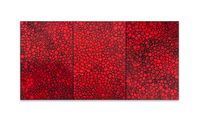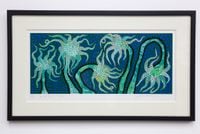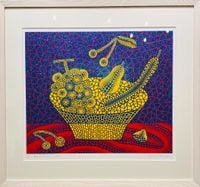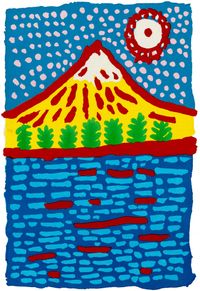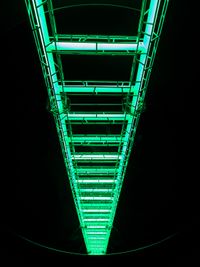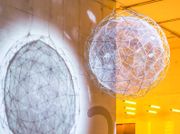Sometimes referred to as the 'princess of polka dots', Yayoi Kusama is widely recognised as one of the best-selling female artists of the 21st century. Her hypnotic, dotty dreamworlds have led to a worldwide museum craze—between 2014 and 2019, more than five million people queued for the artist's exhibitions around the world.
Read MoreBorn into a wealthy but allegedly unhappy family in Matsumoto, Japan, in 1929, Kusama felt discouraged from creating art by her mother and father. As a child, art-making became an act of rebellion for her. Her training as an artist began at Kyoto Municipal School of Arts and Crafts, where she studied nihonga—a form of traditional Japanese painting. However, the artist disagreed with the rigid hierarchy of the genre. In hopes of finding success in the United States, she wrote to painter Georgia O'Keeffe (whose address she had found at the American Embassy in Tokyo) for advice on entering the New York art world. To her surprise, O'Keeffe replied, warning her of the difficulties of working in the city.
In 1958, Yayoi Kusama found the courage to relocate to New York, where she found herself in the thick of the avantgarde movements of the time. Surrounded by Minimalism and Pop art and incorporating elements of both into her work, the artist's critical acclaim is pinned to the 'Infinity Net' series (1958–ongoing) that she began at this time: canvases engulfed by hundreds or thousands of small, colourful loops of paint. In 2014, White No. 28, which belongs to the series, reached USD7.1 million at Christie's.
Yayoi Kusama's artwork has often referred to repetition of form as offering her solace from the traumas she has battled with since her youth. As a young girl, the artist recalls that her mother would ask her to spy on her father and she has referred to the frequently incorporated phallic forms in her work, as seen in her 'Accumulation' series, begun in 1962, as an act of reconciliation with her childhood fears regarding what she might see. 'Accumulation' comprises soft sculptures made of found furniture covered in sewn, white penis forms. Later, the artist would fill entire rooms with these soft forms, such as Compulsion Furniture (Accumulation) (c 1964): a room filled with phallus-covered furniture. The installations that she created in the 1960s were precursors to her best-known infinity rooms of today.
In 1965, mirrors first appeared in Yayoi Kusama's work Infinity Mirror Room—Phalli's Field (1965), in which the floor of a square, mirrored room was covered in a layer of white, stuffed phalluses dotted in red. In recent years, the artist's repetitive dot motifs have spawned a set of infinity mirror-room exhibitions internationally, including Yayoi Kusama: Infinite Obsession, whose worldwide tour reached the biggest global audience for an art exhibition in 2015. In 2017, the Hirshhorn Museum and Sculpture Garden in Washington, DC debuted another touring exhibition titled Yayoi Kusama: Infinity Mirror. Two-hour queueing times did not dampen the enthusiasm of thousands of visitors, who were granted a brief half-minute slot of solitude within the infinity mirror rooms.
A decline in the artist's mental health in the early 1970s saw her return to Japan. In 1977, she checked herself into a psychiatric hospital in Tokyo where she has lived ever since—her studio is located across the road. In 2017, the Yayoi Kusama Museum was founded in Shinjuku Ward and dedicated to her life-long practice, while 2018 marked the release of a Yayoi Kusama documentary, entitled Yayoi Kusama: Infinity. Directed by Heather Lenz, the Yayoi Kusama documentary traces the artist's career, showing her not solely as a product of social media and market success, but an example of perseverance against the odds.
Yayoi Kusama's vibrantly-coloured sculptures occupy numerous sites across the world. In August 2021, her yellow-and-black Pumpkin (1994) was swept away from its spot in Naoshima, Japan, by Typhoon Lupit.
Yayoi Kusama's works have been exhibited internationally, with more recent solo exhibitions including Yayoi Kusama: Infinity Mirror Rooms, Tate Modern, London (2021); Yayoi Kusama, Gropius Bau, Berlin, organised in collaboration with the Tel Aviv Museum of Art (2021); Love is Calling, Institute of Contemporary Art, Boston (2019); Infinitely Kusama, Indianapolis Museum of Art, Indianapolis (2019); Festival of Life and Infinity Nets, David Zwirner, New York (2017); Yayoi Kusama: The obliteration room, Dunedin Public Art Gallery (2016).
Between 2017 and 2019, her solo exhibition Yayoi Kusama: Infinity Mirrors travelled to the Hirshhorn Museum and Sculpture Garden, Washington, D.C.; Seattle Art Museum; The Broad, Los Angeles; Art Gallery of Ontario, Toronto; The Cleveland Museum of Art, Ohio; and High Museum of Art, Atlanta.
John Hurrell | Ocula | 2021
